(Four Ways) Move Users Folder to Another Drive Windows 10 or Windows 11
Move Users Folder to Another Drive Windows 10 or Windows 11
The user folder, a default folder in Windows 10/11, stores various files and folders, including Documents, Pictures, and Downloads, which can consume all available space on the C drive if not managed properly, making it a common issue for users with limited storage.
To free up disk space, you can change the user folder location in Windows 10 or 11. Here are 4 solutions to tweak the user folder location: move user profile to another drive, change user profile location via Windows Settings, use a third-party software to change user profile location, and manually change the user profile location by editing the registry.
| Workable Solutions | Step-by-step Troubleshooting |
|---|---|
| Fix 1. Qiling Disk Master (Easy and Fast) | Step 1. Create a backup file of the user folder; Step 2. Restore the user folder to the destination drive...Full steps |
| Fix 2. Manual Ways |
1. File Explorer...Full steps 2. Windows Settings...Full steps 3. Registry Editor...Full steps |
Qiling Disk Master's latest version allows for a quick and easy transfer of user data, including the Users folder, Desktop, Files, Music, Pictures, Videos, and Downloads, to another drive in just a few seconds. Alternatively, you can try one of the other three methods, but be aware that manual methods may fail and can only transfer files one by one.
- Qiling Disk Master -
Your Smart Windows 11 File Transfer
- Transfer Files, Apps, Settings from Old OS to New Windows 11
- 1-Click Product Key Finder for Windows, Office, Adobe apps.
- C Drive Cleaner & Windows 11 Performance Optimizer.
- Rescue Data When Windows 11 Corrupts or Dies.
Can I Move the Entire Users Folder to Another Drive
You can't move the entire user folder, but you can move specific folders like Downloads, Documents, Pictures, Videos, and Music to another drive.
- Notice:
- Moving the entire user folder can be problematic as it contains important system files, and doing so can lead to data loss and system boot issues. Modifying settings related to the operating system foundation can also result in actual losses, making it crucial to exercise caution when migrating files, especially those related to Windows installation and the operating system itself.
Moving the Users folder in Windows 10 or Windows 11 can be a bit tricky, but it's doable. To free up disk space or change the file location, you can successfully move these folders. However, it's recommended to avoid moving the Users folder to prevent potential fatal risks. If you still want to move it, you can follow the steps to change its location safely.
Move User Folder to Another Drive with Qiling Disk Master
Qiling Disk Master Free is a user-friendly Windows 10/11 transfer software that simplifies the process of transferring a user folder from one hard drive to another, making it the recommended method for average users, and also effectively migrating apps.
If you need to move files, folders, or programs to another drive, you can download a tool that allows you to change the location of these items in just one click.
Here, the guide shows you a simpler way to transfer the user folder from one hard drive to another straightforwardly.
If you need a free tool - Qiling PCTrans Free can help. (Only 2 Apps/files are supported.)
If you need to transfer many files or a large amount of data, consider upgrading to the Pro Edition of the software and follow the provided guidelines for assistance.
Step 1. Create a backup file of the user folder
Launch Qiling Disk Master on your Windows computer. Navigate to the "Backup & Restore" mode and click "File sync" to proceed.

To back up your data, hover your mouse over "Data Backup". Then, confirm the default settings for the file name and file path, or customize them to your preference.
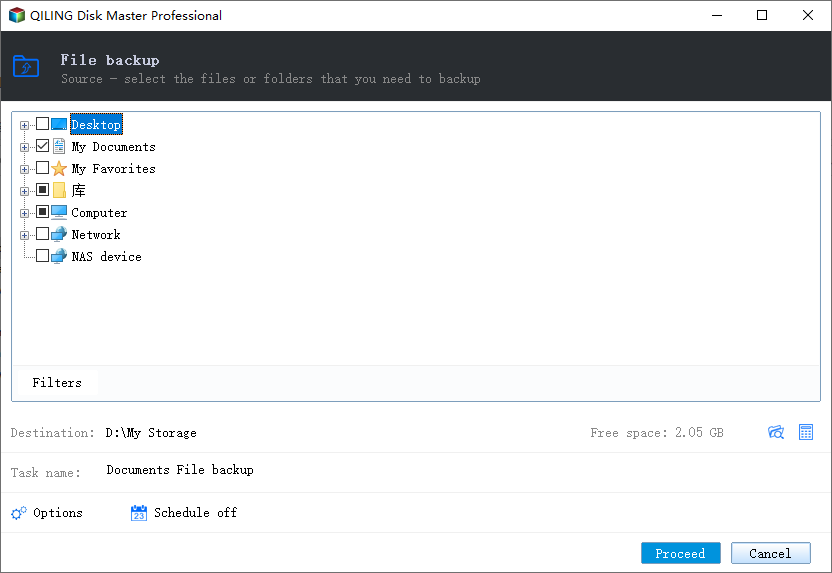
To transfer user folder from one drive to another, hover your mouse over "Files", select the items you want to transfer, and click "Proceed".
Qiling Disk Master enables users to back up their entire user folder, including desktop, files, music, pictures, videos, and downloads, among other contents.
Step 2. Restore the user folder to the destination drive
Launch Qiling Disk Master and navigate to the "Backup and Restore" page to select a transfer method.
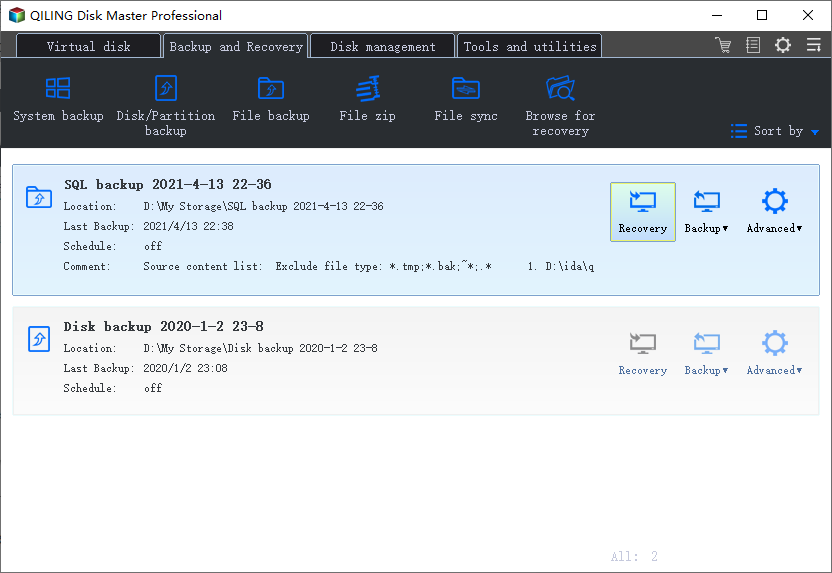
Choose the existing backup file from the interface or navigate to the exact file path where the backup file is located, then click "Restore".
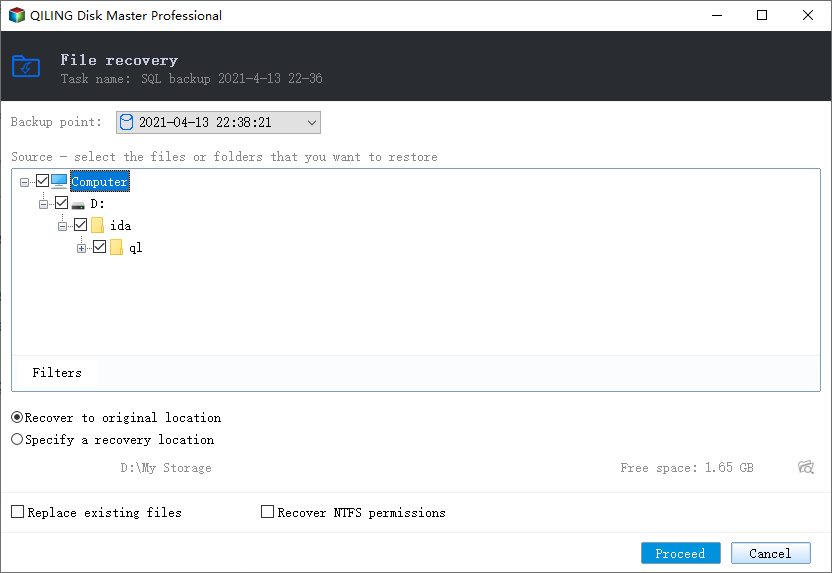
To restore your files, click "Migration Settings" to set the target location on the other hard drive, save changes, and then click "Restore". Wait for the transfer process to complete.
More Info: Can I Move Users Folder to Another PC
Using the Windows 10/11 easy transfer tool is the best way to transfer files and settings from your old PC to your new one. This tool makes the process seamless and efficient, allowing you to easily move your files, settings, and even your desktop background to your new device. It's a convenient and hassle-free way to get up and running on your new PC, and is often the preferred method for making the transition.
Windows 10/11 Easy Transfer Tool:Transfer data to new PC/OS
To overcome the issue of Windows Easy Transfer not being available in Windows 10/11, we offer a reliable alternative tool that can assist with the transfer process.
P.S. When moving a user's folder to another drive, the administrator folder cannot be relocated, but it can be transferred to another PC.
Windows 10/11 Move Users Folder to Another Drive (3 Manual Way)
Some Windows 10 or Windows 11 users want to move their Users folder to free up space on their system disk, while others want to make a copy of the folder for storage on a different drive.
| Solutiond | Pros | Cons |
|---|---|---|
| Using File Explorer | Move user folder to another drive one by one easily. | Files can not move at one time. |
| Using Windows Settings | Change files location by a few clicks. | Can not save files to the specific folder. |
| Using Registry Editor | Quickly locate your folder. | Hard to use. May fail on Windows 10/11. |
1. Windows 10/11 Move User Folder to Another Drive via File Explorer
Step 1. Open File Explorer.
Step 2. To access the target hard drive, click on "This PC" on your computer, then select the target hard drive from the "Devices and drives" option.
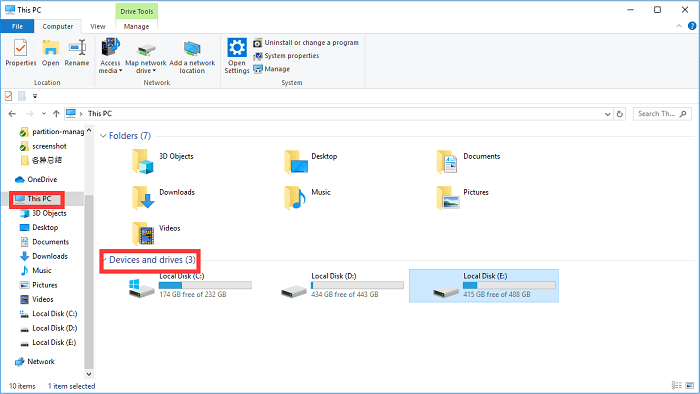
Step 3. To save files in a specific location, open the new drive location, choose the location where you want to save, click "New Folder" and name it as "Documents", "Downloads", "Music", "Pictures", or "Videos".
Step 4. Go back to the user folder's location (C drive).
Step 5. Right-click the Documents or Downloads folder, then choose Properties.
Step 6. Select the Location tab, then click Move to choose the new file location and click OK to apply.
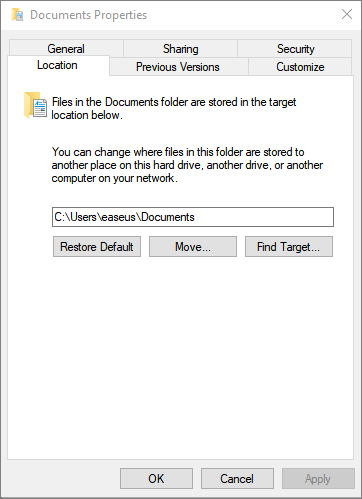
Step 7. Select the folder with the same name in E drive.
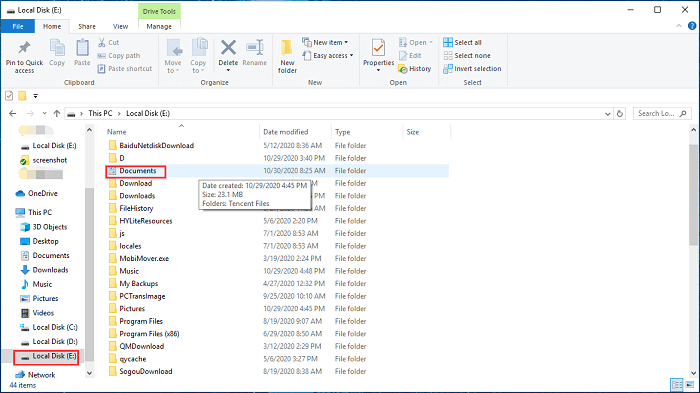
Step 8. Click Apply and Yes.
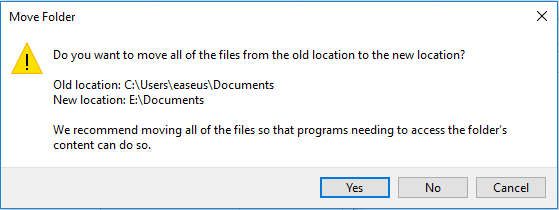
- Tip
- To save your data on the E drive, simply place it there. If you want to restore it to its default location, right-click the folder, go to Properties, and select Restore Default under the Location option. This will revert the folder's location back to its original setting.
The migrated folder will be automatically updated in the quick access bar.
Tips: How to Restore the Folder Location
If you regret to change the folder's location, you can apply the steps below.
Step 1. Run File Explorer and move to the user folder location.
Step 2. Right-click on the folder, choose Properties, select Restore Default under the Location tab, and the folder's default location will be restored.
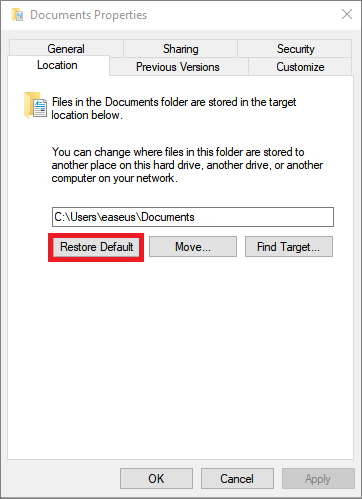
2. Windows 10/11 Move Users Folder with Windows Settings
Step 1. To change where new content is saved on Windows, go to Settings > System > Storage > Change where new content is saved.
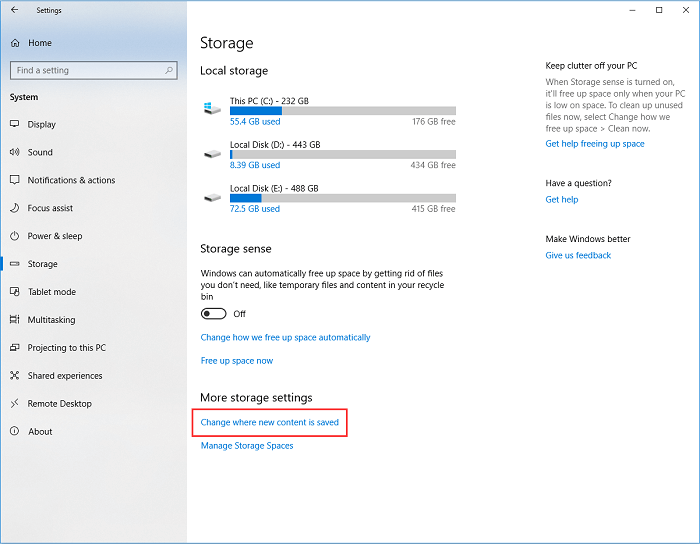
Step 2. Choose the save location.
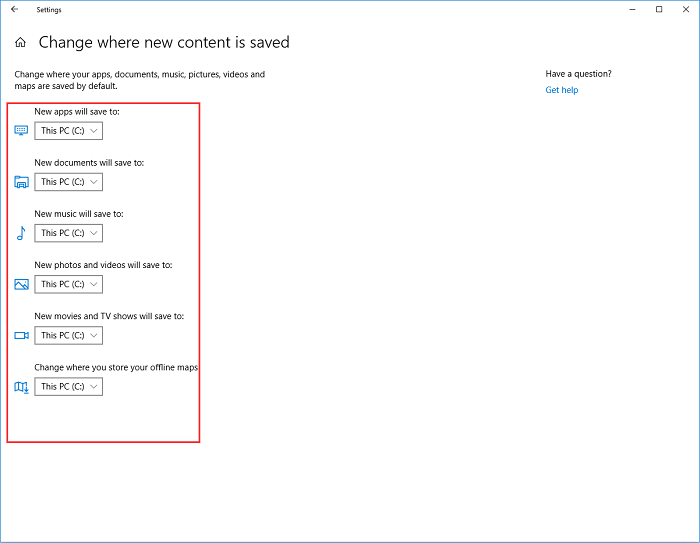
3. Windows 10/11 Move Users Folder via Registry Editor
Step 1. To open the Registry Editor on a Windows computer, press the Windows key + R to bring up the Run box, type "regedit" and press Enter. This will open the Registry Editor, allowing you to view and edit the Windows Registry.
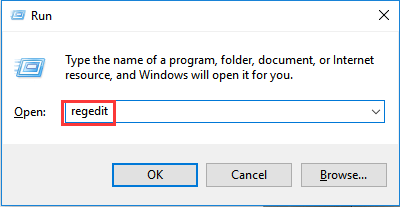
Step 2. Follow the path: HKEY_CURRENT_USER\SOFTWARE\Microsoft\Windows\CurrentVersion\Explorer\User Shell Folders
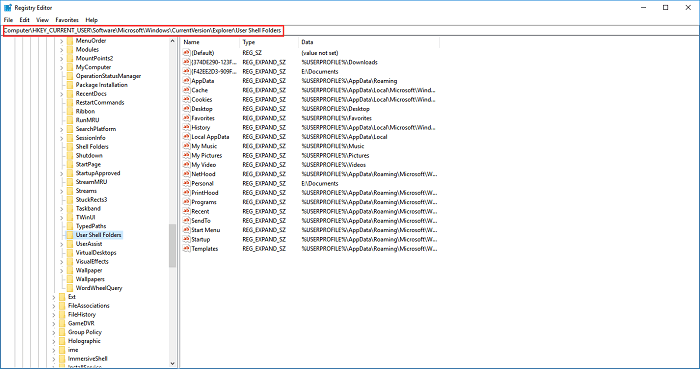
Step 3. Right-click files and click Modify.
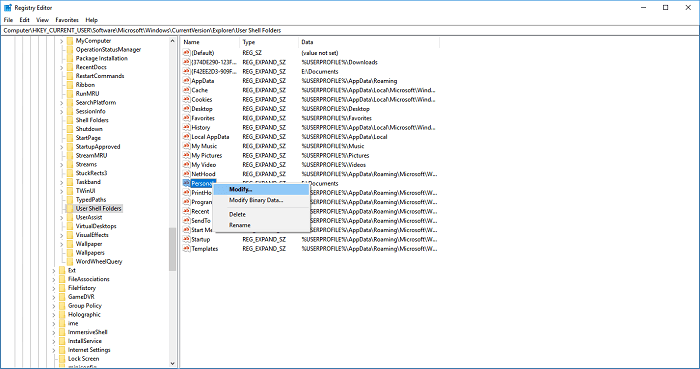
Step 4. Input the drive location. Then restart your PC.
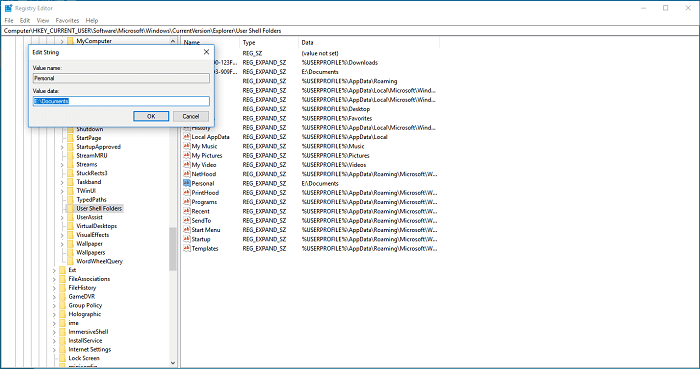
As you can tell, the three-I don't understand what you're asking. Could you please provide more context or clarify what you're trying to say? I'll do my best to assist you.
One notable limitation of the three methods is that they won't be helpful when moving multiple folders at once to a different drive on a separate computer. In such cases, a more comprehensive solution like Qiling Disk Master might be more suitable.
Related Articles
- 4 Quick-Fixes: File Transfer Speed Slow Between 2 Computers on LAN
- How to Move World of Warcraft to Another Drive/Computer
- How to Fix Dell Laptop Black Screen
- Best Free Data Migration Software for Data and Applications Transfer